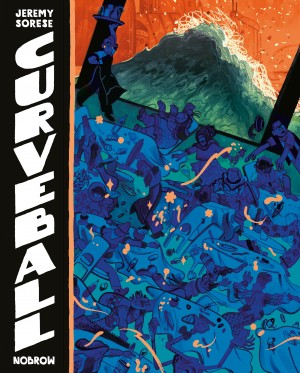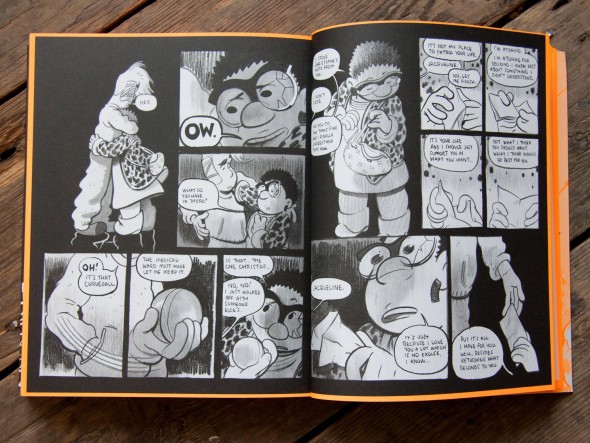Click here for part one: The Sculptor and Beautiful Darkness
Click here for part three: Crossed + One Hundred and Stand Still, Stay Silent.
Click here for part four: Summary post, including a list of notable sff graphic novels of 2015.
Since it’s Hugo nomination season, I’ve been making an effort to read every notable science fiction or fantasy graphic novel that came out in 2015. And you know what? It’s hopeless! There are just too many coming out. I’ll never get around to reading them all. And probably some of the best ones, I won’t even find out about until after Hugo nominations are over. (That’s what happened last year.)
And of course, by limiting myself to graphic novels, I’m missing out on any number of wonderful webcomics and floppy comics. (If you’re in the market for great sff webcomics, I’d highly recommend checking out Dicebox and Family Man and O Human Star and Stand Still Stay Silent and Modest Medusa and Strong Female Protagonist and Evan Dahm’s extraordinary Vattu and probably many more.)
So I can’t cover them all. But some of the ones I’ve been reading are awfully good, and that’s the real point of this exercise. So, onto the reviews:
 Of all the science fiction graphic novels I read this year, Jeremy Sorese’s Curveball did the best at immersing me in a science-fiction world. This is the power of comics; rather than trying to explain the futuristic technology in scientifically plausible detail (something that I’m not sure Sorese could do), comics can show us how it feels for the characters living in that world.
Of all the science fiction graphic novels I read this year, Jeremy Sorese’s Curveball did the best at immersing me in a science-fiction world. This is the power of comics; rather than trying to explain the futuristic technology in scientifically plausible detail (something that I’m not sure Sorese could do), comics can show us how it feels for the characters living in that world.
Curveball is set in a world of robots and web-connected tech which is constantly on the danger of breaking down, sometimes disaterously; plus, there’s a war. But all of that is just the backdrop for Curveball‘s real concerns, which are friendship, relationships and main character Avery’s broken heart from a bad romance.
What I loved about Curveball, in addition to the feeling of immersion in a new world, was Sorese’s art, which is unabashedly cartooney, full of gray smudgy energy, and feels completely unique. Sorese also chose to use neon orange as a spot color, mainly to show where the sci-fi tech was present and what it was doing, a daring choice that ended up being effective.
Curveball‘s story is sprawling. This is not a book for readers who require a carefully structured narrative where every page fits cleanly into a clear-cut story arc. (If that’s what you’re looking for, see the previous recommendation of The Sculptor.) The story wanders here and there (at 420 pages, there’s room!), often feeling improvised, and early in the book the meandering feeling prevents the story from gathering momentum. But by the end – as Avery’s broken heart narrative came to the fore – momentum wasn’t a problem.
Another nice touch: Curveball has multiple gender-queer, gender-ambiguous, and non-binary gender characters, including main character Avery. This is presented in such an everyday manner that I’m not sure all readers will notice; in Curveball‘s world, being non-binary is unremarkable, and thus not remarked on. (Sorese has said that he considers the world of Curveball “utopian”; I wonder if this is part of what he’s referring to.)
Curveball does have flaws; the art, although beautiful, was occasionally hard to make out. (Unfortunately, the front cover is one of those few occasions.) In particular, the occasional bit of orange-on-orange art was almost impossible to read, and I suspect a lot of readers over 40 will have similar difficulties. And the main character Avery, despite being non-binary, still felt a bit flat, like dozens of listless, heartsick protagonists I’ve read before. The characterization of Avery’s best friend, Jacqueline, popped a lot more, and I sometimes wished that she had been the central character. (Avery and Jacqueline’s relationship sometimes felt a little bit like Maggie and Hopey.)
Still, this was an impressive first graphic novel, one of the most interesting sf/f graphic novels of 2015. I can’t wait to see what Sorese’s next graphic novel is like.
 Nimona, by Noelle Stevenson, might be the most charming comic I read all year.
Nimona, by Noelle Stevenson, might be the most charming comic I read all year.
Nimona is the funny, touching, and hard to put down story of a young girl, Nimona, who apprentices herself to a gentle-hearted super villain named Ballister Blackheart (Ballister is the point of view character for the book). The early chapters of Nimona are concerned with the long-ongoing and rather wacky war between Ballister and his heroic nemesis Ambrosius Goldenloin. A lot of the humor comes from the ways Ballister’s attempts at evildoing are complicated by Nimona’s sometimes clumsy, sometimes frighteningly effective, assistance.
But as we read on, it becomes clear that the mystery of Nimona’s origins (she has shape-shifting powers), and her difficulty fitting into the world, are Stevenson’s real concerns. The assistant is the most consequential character in this world, and also the character who is suffering the most; but the hero and villain, caught up in their heroic battles, take a long time to realize that. It’s a story that begins funny and violent and winds up heartbreaking (but still violent).
 Stevenson’s art is simple, energetic, and expressive, like a slightly more controlled Kate Beaton. And the three main characters are well written and defy simple stereotypes.
Stevenson’s art is simple, energetic, and expressive, like a slightly more controlled Kate Beaton. And the three main characters are well written and defy simple stereotypes.
I did find Nimona a little self-contrary; the story urges us to see its three main characters as more than simple genre tropes, but Stevenson also relies unquestionably on some genre tropes. Specifically, the way Nimona kills minor (and usually nameless) characters left and right is never seriously questioned or dealt with, which felt odd to me in such a generally thoughtful narrative. And the artwork, while charming and clear, isn’t very ambitious or experimental compared to Curveball or The Sculptor. But not everything needs to push the boundaries of the form.
UPDATE: Some folks have asked if Nimona is eligible for a 2015 Hugo, since it was published in webcomic form before 2015. But according to Stevenson in an interview, she redrew the earliest chapters for the book, and added new story pages, including (but not limited to) the epilogue. This means that the 2015 book contains significant new material that hadn’t been published before 2015, and so Nimona is Hugo-eligible. (As I understand the rules.)




Pingback: 2015 Science Fiction and Fantasy Graphic Novel Recommendations, part one: The Sculptor and Beautiful Darkness | Alas, a Blog
I also thought this while reading the book, but by the time I reached the end, I decided that her willingness to murder nameless minions was the first clue about her real character.
Pingback: 2015 Science Fiction and Fantasy Graphic Novel Recommendations, part four: Summary | Alas, a Blog